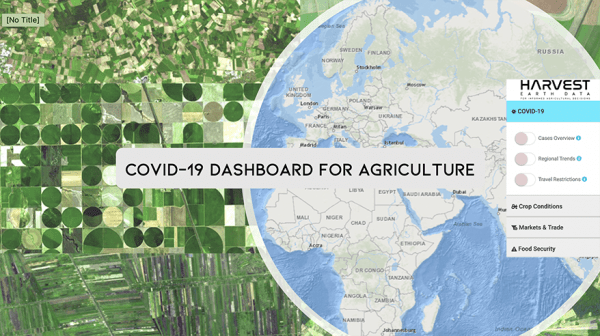GEOG Researchers Create COVID-19 Dashboard for Food Systems Analysis
As COVID-19 continues to touch nearly every aspect of our daily lives, the impacts that the virus is having on agriculture and food production are a primary concern given the global, interconnected nature of the food system. Thanks to the many advancements made in satellite technology particularly in recent years, today we have access to an expansive amount of remotely-sensed Earth observation data. This satellite data is critical in enabling experts to rapidly respond to the pressing need for free and open-use analytical tools, especially in the face of changes to policy, labor availability, logistics, and food prices brought on by COVID-19.
Analyzing the various factors that contribute to food insecurity can be difficult to meaningfully capture due to the sheer number of variables that impact food production and food markets. This is true even during times when researchers are able to travel freely for data collection, let alone during a global pandemic that has caused loss of life, business closures, financial hardship, restricted borders, and decreased access to nutritious food for many. Thus, a real need exists for easily-accessible tools that enable agricultural stakeholders to gain a comprehensive understanding of potential COVID-19 impacts as they relate to food availability.
In response to this need, researchers of the NASA Harvest Consortium led by researchers at the University of Maryland Department of Geographical Sciences have been hard at work creating the new NASA Harvest COVID-19 Dashboard to help quantify the pandemic’s impact on agricultural production and food security around the world. Led by co-principal investigators Dr. Mike Humber (Assistant Research Professor) and Dr. Inbal Becker-Reshef (Associate Research Professor and NASA Harvest Program Director) and co-investigator Estefania Puricelli, head software developers John Keniston, Antonio Sanchez, and the Harvest Hub team located at UMD have developed this publicly available web-based tool with end users in mind. The primary goal of the dashboard is to provide users with supply relevant chain information that will facilitate analysis of the COVID-19 pandemic in relation to crop production, market price volatility, food availability, and rapidly evolving policy changes.
{"preview_thumbnail":"/sites/geog.umd.edu/files/styles/video_embed_wysiwyg_preview/public/video_thumbnails/QyPhcpB6HCk.jpg?itok=0NFHJ5vl","video_url":"https://www.youtube.com/watch?v=QyPhcpB6HCk&feature=emb_logo","settings":{"responsive":1,"width":"854","height":"480","autoplay":1},"settings_summary":["Embedded Video (Responsive, autoplaying)."]}
The interactive dashboard is easy to navigate and provides academics, economists, citizen scientists, and any other interested analysts with access to a vast amount of agricultural-related data in the context of COVID-19. Uses for the dashboard range from comparing crop production on a national scale pre-dating the start of the pandemic to understanding the changing cost of commodity crops in agricultural markets over time. The dashboard allows users to search for datasets published by partners and affiliate institutions as well as other datasets relevant to agricultural monitoring and food security. This tool can be freely accessed from any web browser and data can be downloaded, visualized, and analyzed from one convenient location.
“Understanding global food systems in terms of production, logistics, economics, and policy is and always has been a challenge - COVID-19 has highlighted how important it is to really understand the relationships between these different facets of the agricultural supply chain and a big part of that is bringing together the data,” says Dr. Humber.
“The current pandemic is the latest episode highlighting the urgent need for a global, comprehensive, multi-disciplinary food supply-chain information system. The NASA Harvest COVID-19 dashboard provides a significant step towards fulfilling this need by bringing together a range of satellite-based crop indicators alongside real-time economic data, trade & price information, food security indicators and policy information. We look forward to feedback from the community and continuing to evolve and advance this tool for supporting assessments of the complex and rapidly evolving global food supply flows," adds Dr. Inbal Becker-Reshef.
Explore the Storymap to learn more about the NASA Harvest COVID-19 Dashboard and how to use it. Email info@nasaharvest.org if you would like to contribute data.
Published on Wed, 12/02/2020 - 16:55


